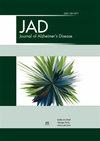受体贩运受损在阿尔茨海默病中介导 APOE4 病理效应的作用
IF 3.4
3区 医学
Q2 NEUROSCIENCES
引用次数: 0
摘要
背景:载脂蛋白 E4(APOE4)是阿尔茨海默病最普遍的遗传风险因素。多项研究表明,载脂蛋白 E4 与其受体结合与受体内化和在细胞内积累有关。重要的是,这种现象也发生在其他非载脂蛋白E受体上。基于这些观察结果,我们假设 APOE4 的病理效应是由不同受体(APOER2、LRP1、IR、VEGFR)的生命周期受损介导的。研究目的研究 APOE 基因型对受体蛋白水平和分区的影响。方法:制备小鼠原代神经元:制备 APOE3 或 APOE4 靶向替代小鼠或 APOE-KO 小鼠的原代小鼠神经元。利用免疫荧光染色法评估这些神经元中的特定受体蛋白水平。此外,还通过细胞表面生物素化试验和酶联免疫吸附试验评估了这些受体的表面膜蛋白水平。通过双重染色和共聚焦显微镜,然后进行共聚焦分析,评估受体与细胞内分区的共聚焦情况。最后,用CRISPR/Cas9系统敲除LRP1或APOER2,以研究它们在介导APOE4对受体的影响中的作用。结果:我们的研究结果表明,APOE4 的受体水平较低,特别是在膜表面。此外,APOE4 还以两种模式影响这些受体的分区:第一种模式是在 LRP1 中观察到的,与许多细胞内分区中受体水平的降低有关。第二种是对其他受体的影响,与它们在早期内体中的积累和在晚期内体中的减少有关。结论:这些结果提供了一个统一的机制,即 APOE4 驱动各种受体的下调,而这些受体在不同的 APOE4 相关病理过程中发挥着重要作用。本文章由计算机程序翻译,如有差异,请以英文原文为准。
The Role of Impaired Receptor Trafficking in Mediating the Pathological Effects of APOE4 in Alzheimer’s Disease
Background: Apolipoprotein E4 (APOE4) is the most prevalent genetic risk factor of Alzheimer’s disease. Several studies suggest that APOE4 binding to its receptors is associated with their internalization and accumulation in intracellular compartments. Importantly, this phenomenon also occurs with other, non-ApoE receptors. Based on these observations, we hypothesized that APOE4 pathological effects are mediated by impairment in the life cycle of distinct receptors (APOER2, LRP1, IR, VEGFR). Objective: To examine the effects of APOE genotype on receptors protein levels and compartmentalization. Methods: Primary mouse neurons were prepared from APOE3 or APOE4 targeted replacement mice, or APOE-KO mice. Specific receptors protein levels were evaluated in these neurons, utilizing immunofluorescent staining. Additionally, surface membrane protein levels of those receptors were assessed by cell surface biotinylation assay and ELISA. Receptors’ colocalization with intracellular compartments was assessed by double staining and confocal microscopy, followed by colocalization analysis. Finally, LRP1 or APOER2 were knocked-down with CRISPR/Cas9 system to examine their role in mediating APOE4 effects on the receptors. Results: Our results revealed lower receptors’ levels in APOE4, specifically on the membrane surface. Additionally, APOE4 affects the compartmentation of these receptors in two patterns: the first was observed with LRP1 and was associated with decreased receptor levels in numerous intracellular compartments. The second was obtained with the other receptors and was associated with their accumulation in early endosomes and their decrease in the late endosomes. Conclusions: These results provide a unifying mechanism, in which APOE4 drives the down regulation of various receptors, which plays important roles in distinct APOE4 related pathological processes.
求助全文
通过发布文献求助,成功后即可免费获取论文全文。
去求助
来源期刊

Journal of Alzheimer's Disease
医学-神经科学
CiteScore
6.40
自引率
7.50%
发文量
1327
审稿时长
2 months
期刊介绍:
The Journal of Alzheimer''s Disease (JAD) is an international multidisciplinary journal to facilitate progress in understanding the etiology, pathogenesis, epidemiology, genetics, behavior, treatment and psychology of Alzheimer''s disease. The journal publishes research reports, reviews, short communications, hypotheses, ethics reviews, book reviews, and letters-to-the-editor. The journal is dedicated to providing an open forum for original research that will expedite our fundamental understanding of Alzheimer''s disease.
 求助内容:
求助内容: 应助结果提醒方式:
应助结果提醒方式:


